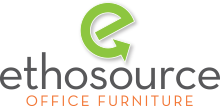Once upon a time, the office was viewed as a place to get work done. If you weren’t there, it was impossible to be productive. As a result, employers had serious trust issues when employees requested to “work from home” for the day.
Well, times have certainly changed. We learned that you actually can work remotely and be really efficient. But that doesn’t mean the office is going away. Because whether we knew it at the time or not, the office has never been simply just about work.
What was once a space centered on carrying out routine tasks and meetings has now been realized as a space for culture; designed for fostering connections, encouraging learning, and nurturing innovative collaboration.
So in Part Two of our hybrid office series, we’re taking a look at the various types of hybrid offices, and what business owners and leaders need to think about when making the switch in their space.

5 Hybrid Office Models
The hybrid office isn’t one-size-fits all. In fact, it can really mean whatever you want it to if it works best for your business and employees. But here are the top five hybrid/remote work models that owners are considering today.
-
Office-Centric Hybrid
While office-centric hybrid companies require teams to be in the office most of the time, they will designate one or two days a week for employees to work remotely. This model typically supports the belief that employees working in the same space are able to more effectively develop connections, coordinate on tasks and projects, and feel a sense of community. Many of these models also allow employees to set their own hours.
-
Fully Flexible Hybrid
A fully flexible hybrid approach allows employees to choose when they’d like to work in-office versus remotely. But this model requires a little more organizational intentionality, or it can cause internal challenges. In addition to being more difficult for coordination when presence is less predictable, it can also create status tiers and inequities among employees favoring those who show up more often.
-
Remote-Friendly Hybrid
For employers looking to set some additional boundaries on employees working remotely, they’ll consider a remote-friendly approach. This model may allow employees to schedule remote days, but limit what days of the week they can select. It could also involve a certain percentage (up to 25%) of employees working remote full-time. As you could probably guess, this model does invite many of the same problems as the fully flexible model in terms of creating employee inequities for those in the office, but it does have its hiring perks in recruiting non-local talent.
-
Hybrid Remote-Office
Think of this model as employees having a catalog of options to choose from — ranging from fully remote to in-office full time, or a mix of both. Giving team members the freedom of choice is certainly attractive to both current and potential new employees, but issues can arise if managerial personnel are the ones opting for in-office full-time.
-
Remote-First
Last but not least is the remote-first approach. Note that this model is different from remote-friendly in that it not only allows employees to work remotely — it empowers them to do so. But in addition to the psychological difference here, there’s also an operational difference, requiring these companies to build their processes and culture around a primarily remote team.
Things to Consider When Going Hybrid
Choosing the right model for your company is the first step, but like each of the options above show, there will be other aspects of the transition to think about. Here are a few examples:
- Strengthening WIFI/Increasing storage, to ensure high-quality connections for digital communications, and enable support for both remote and on-site data collection and exchange.
- Adjusting your workflows, not only in terms of sharing information and communication, but your furniture as well. Things like standing desks, more options for privacy, etc. that people have come to expect from working from home.
- Enabling asynchronous work, which may mean allowing greater flexibility in deadlines or meeting times, typically constrained by a 9-5 work day.
- Clear rules for using shared data/spaces, setting company-wide expectations and standards for practices like communicating virtually, protecting internal data, accessing on-site locations, etc.
- Moving to more digital tools, establishing the platforms and processes to streamline communication and collaboration for those both in and out of the office, and understanding how quickly employees can adapt.
- Measuring and managing performance, what will this now look like without all new variables to consider? What new routines or methods will strengthen the essential parts of our mission?
We’re not quite finished yet. Stay tuned for Part Three: What the Hybrid Office Really Looks Like & How to Get There as we take the final step on the hybrid journey to help you design your physical space for your new work model. In the meantime, contact us to help you get started planning your office design today.
